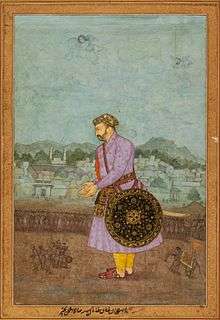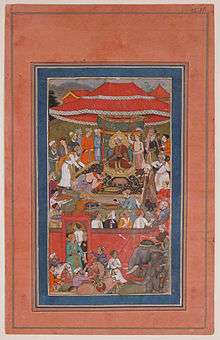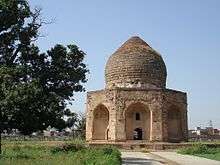Abu'l-Hasan Asaf Khan
| Abu'l-Hasan Khan | |
|---|---|
 Portrait of Asaf Khan | |
| Grand Vizier of the Mughal Empire | |
|
In office 1628–1641 | |
| Monarch | Shah Jahan |
| Wakil of the Mughal Empire | |
|
In office 1611–1627 | |
| Monarch | Jahangir |
| Personal details | |
| Born |
Abu'l-Hasan c. 1569 Safavid Iran |
| Died |
12 June 1641 (aged 71-72) Bundi, Mughal India |
| Spouse(s) | Diwanji Begum |
| Children |
Mumtaz Mahal Shaista Khan Malika Banu Begum Parwar Khanam Farzana Begum |
| Mother | Asmat Begam |
| Father | Mirza Ghiyas Beg |
| Relatives |
Mohammad-Sharif (brother) Ebrahim Khan Fath Jang (brother) E'teqad Khan (brother) Nur Jahan (sister) Jahangir (brother-in-law) Shah Jahan (son-in-law) |
Abu'l-Hasan[1] (c. 1569 - 12 June 1641) entitled by the Mughal emperor Jahangir as Asaf Khan, was the Grand Vizier (Prime minister) of the fifth Mughal emperor Shah Jahan.[2][3] He previously served as the wakil (the highest Mughal administrative office) of Shah Jahan's father, Jahangir.[4] Asaf Khan is perhaps best known for being the father of Arjumand Banu Begum (better known by her title Mumtaz Mahal), the chief consort of Shah Jahan and the older brother of Empress Nur Jahan,[5] the chief consort of Jahangir.
Family
Asaf Khan was the son of the Persian noble Mirza Ghias Beg (popularly known by his title of Itimad-ud-Daulah),[6] who served as the Prime minister of the Mughal emperor Jahangir. Ghiyas Beg was a native of Tehran, and was the youngest son of Khvajeh Mohammad-Sharif,[7] a poet and vizier of Mohammad Khan Tekkelu and his son Tatar Soltan, who was the governor of the Safavid province of Khorasan. Asaf Khan's mother, Asmat Begam, was the daughter of Mirza Ala-ud-Daula Aqa Mulla.[8]
Both of Asaf Khan's parents were descendants of illustrious families – Ghias Beg from Muhammad Sharif and Asmat Begam from the Aqa Mulla clan.[9] Asaf Khan's family had come to India impoverished in 1577, when his father, Mirza Ghias Beg, was taken into the service of Emperor Akbar in Agra.[10]
Marriage
In his prime youth, Asaf Khan was married to Diwanji Begum, the daughter of a Persian noble, Khwaja Ghias-ud-din of Qazvin.[11][12] The couple had at least five children together: Arjumand Banu Begum (later known as Mumtaz Mahal), Malika Banu Begum,[13] Parwar Khanam, Farzana Begum,[13] and a son, Shaista Khan.
Arjumand was married to Jahangir's third son, Prince Khurram (later known as Shah Jahan) in 1612 and became his most beloved wife. Parwar Khanam was married to Mohtashim Khan, the son of Jahangir's foster brother Qutubuddin Koka.
Governor of Lahore

Mirza Abul Hasan Asaf Khan was appointed Governor of Lahore by Emperor Jahangir in 1625. After the demise of Jahangir in 1627, he was instrumental in securing the accession of his son-in-law Shah Jahan by colluding with Dawar Bakht (Jahangir's other son) and defeating the acting emperor Prince Shahryar (Nur Jahan's son-in-law, married to her daughter by her previous marriage to Sher Afgan) in a battle near Lahore. Asaf Khan enjoyed a position even more elevated than in the preceding reign and retained it until 1632, when he failed in the siege of Bijapur, from which time he seems to have lost favour.
Positions
- Grand Vizier (Vazir-e ala of Mughal) – 1628–41
- Subehdar of Lahore – 1625–27
- Subehdar of Gujrat Subah – 1630–39
- Faujdar of Gagron (Malwa Subah) – 1635–41
Death and burial place

Asaf Khan died on 12 June 1641 while engaged in fighting against the forces of rebel Raja Jagat Singh Pathania. Asaf Khan left an immense fortune, in spite of the quarter of a million sterling that his palace at Lahore cost him.[15] His tomb was built in Shahdara Bagh, Lahore, as per Shah Jahan's orders. It lies west of the Tomb of Nur Jahan and adjacent to the Tomb of Jahangir.[4]
See also
References
- ↑ Banks Findly 1993, p. 39
- ↑ Pletcher, edited by Kenneth (2011). The History of India (1st ed.). Chicago: Britannica Educational Pub. p. 179. ISBN 9781615302017.
- ↑ Hansen, Waldemar (1972). The peacock throne : the drama of Mogul India (1. Indian ed., repr. ed.). Delhi: Motilal Banarsidass. p. 87. ISBN 9788120802254.
- 1 2 Ruggles, D. Fairchild (2008). Islamic gardens and landscapes. Philadelphia: University of Pennsylvania Press. p. 198. ISBN 0812207289.
- ↑ Kinra, Rajeev (2015). Writing Self, Writing Empire: Chandar Bhan Brahman and the Cultural World of the Indo-Persian State Secretary. Univ of California Press. p. 30. ISBN 9780520286467.
- ↑ Tillotson 2012, p. 194.
- ↑ Prasad, Ram Chandra (1980). Early English Travellers in India: A Study in the Travel Literature of the Elizabethan and Jacobean Periods with Particular Reference to India. Motilal Banarsidass Publ. p. 96. ISBN 9788120824652.
- ↑ Shujauddin, Mohammad; Shujauddin, Razia (1967). The Life and Times of Noor Jahan. Caravan Book House. p. 1.
- ↑ Banks Findly 1993, p. 9
- ↑ Thackeray, Frank W.; editors, John E. Findling, (2012). Events that formed the modern world : from the European Renaissance through the War on Terror. Santa Barbara, Calif.: ABC-CLIO. p. 254. ISBN 9781598849011.
- ↑ "Journal of the Research Society of Pakistan". 35. Research Society of Pakistan. 1998: 53. Retrieved 12 September 2017.
- ↑ Ahmad, Moin-ud-din (1924). The Taj and Its Environments: With 8 Illus. from Photos., 1 Map, and 4 Plans. R. G. Bansal. p. 101.
- 1 2 Sarker, Kobita (2007). Shah Jahan and his paradise on earth : the story of Shah Jahan's creations in Agra and Shahjahanabad in the golden days of the Mughals (1. publ. ed.). Kolkata: K.P. Bagchi & Co. p. 77. ISBN 9788170743002.
- ↑ unknown (1604). "Asaf khan Presents Offerings. Folio from the Davis Album". 17th Century Mughals & Marathas. Archived from the original on 2013-12-03.
- ↑ History of India : in nine volumes. New York, N.Y.: Cosimo Inc. 2008. p. 100. ISBN 160520496X.
External links
| Wikimedia Commons has media related to Mirza Abul Hasan Jaafar Beg alias Asaf Khan. |